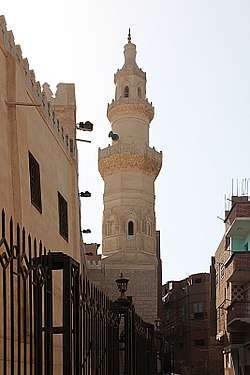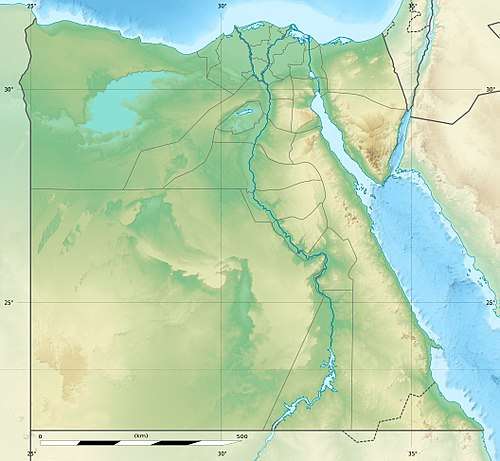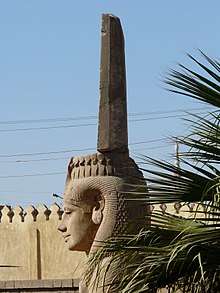Akhmim
Akhmim (Arabic: أخميم, pronounced [ʔæxˈmiːm]; Akhmimic Coptic: ⳉⲙⲓⲙ, pronounced [xmiːm]; Sahidic/Bohairic Coptic: ϣⲙⲓⲛ pronounced [ʃmiːn]) is a city in the Sohag Governorate of Upper Egypt. Referred to by the ancient Greeks as Khemmis or Chemmis (Ancient Greek: Χέμμις)[2] and Panopolis (Ancient Greek: Πανὸς πόλις)[3], it is located on the east bank of the Nile, 4 miles to the northeast of Sohag.
Akhmim ϣⲙⲓⲛ | |
|---|---|
 Prince Hasan Mosque | |
 Akhmim Location within Egypt | |
| Coordinates: 26°34′N 31°45′E | |
| Country | |
| Governorate | Sohag |
| Time zone | UTC+2 (EET) |
History

| jp or jpw[1][4] in hieroglyphs |
|---|
| ḫn(t) mnw[2] in hieroglyphs |
|---|
Akhmim was known in Ancient Egypt as Ipu, Apu (according to Brugsch the name is related to the nearby village of Kafr Abou)[5] or Khent-min. It was the capital of the ninth (Chemmite) nome of Upper Egypt. The city is a suggested hometown for Yuya, the official of Tuthmosis IV and Amenhotep III. The ithyphallic Min (whom the Greeks identified with Pan) was worshipped here as "the strong Horus." Herodotus mentions the temple dedicated to Perseus and asserts that Chemmis was remarkable for the celebration of games in honor of that hero, after the manner of the Greeks, at which prizes were given; as a matter of fact some representations are known of Nubians and people of Punt (southern coastal Sudan and the Eritrean coast) clambering up poles before the god Min. Min was especially a god of the desert routes on the east of Egypt, and the trading tribes are likely to have gathered to his festivals for business and pleasure at Coptos (which was really near Neapolis) even more than at Akhmim. Herodotus perhaps confused Coptos with Chemmis. Strabo mentions linen-weaving and stone-cutting as ancient industries of Panopolis, and it is not altogether a coincidence that the cemetery of Akhmim is one of the chief sources of the beautiful textiles of Roman and Christian age, that are brought from Egypt.[6]

In the Christian Coptic era, Akhmim was written in Sahidic Coptic: ϣⲙⲓⲛ/ⲭⲙⲓⲛ/ⲭⲙⲓⲙ Shmin/Kmin/Kmim but was probably pronounced locally something like Khmin or Khmim. Monasteries abounded in this region from a very early date. Shenouda the Archimandrite (348–466) was a monk at Athribis near Akhmim. Some years earlier Nestorius, the exiled ex-patriarch of Constantinople, had died at an old age in the neighborhood of Akhmim. Nonnus, the Greek poet, was born at Panopolis at the end of the 4th century.[6] The bishopric of Panopolis, a suffragan of Antinoë in Thebais Prima, is included in the Catholic Church's list of titular sees.[7] Among the bishops of Panopolis, Le Quien mentions [8] Arius, friend of Saint Pachomius who had built three convents in the city, Sabinus, and Menas. Excavations at Akhmim have disclosed numerous Christian manuscripts, among them fragments of the Book of Henoch, of the Gospel, and of the Apocalypse of Peter, the Acts of the Council of Ephesus, as well as numerous other Christian inscriptions.
In the 13th century AD, a very imposing temple still stood in Akhmim.[6] Today, little of its past glory remains. Nothing is left of the town, the temples were almost completely dismantled, and their material reused in the later Middle Ages. The extensive cemeteries of ancient Akhmim are yet to be fully explored. The destroyed corner of a Greco-Roman period temple with colossal statues of Ramesses II and Meritamen were discovered in 1981.
Climate
Köppen-Geiger climate classification system classifies its climate as hot desert (BWh).
| Climate data for Akhmim | |||||||||||||
|---|---|---|---|---|---|---|---|---|---|---|---|---|---|
| Month | Jan | Feb | Mar | Apr | May | Jun | Jul | Aug | Sep | Oct | Nov | Dec | Year |
| Average high °C (°F) | 22.1 (71.8) |
24 (75) |
27.9 (82.2) |
33 (91) |
36.1 (97.0) |
37.9 (100.2) |
37.2 (99.0) |
37.4 (99.3) |
34.2 (93.6) |
31.9 (89.4) |
28.4 (83.1) |
23.4 (74.1) |
31.1 (88.0) |
| Daily mean °C (°F) | 13.6 (56.5) |
15.1 (59.2) |
18.5 (65.3) |
23.4 (74.1) |
27 (81) |
29.2 (84.6) |
28.9 (84.0) |
29.3 (84.7) |
27.2 (81.0) |
24.9 (76.8) |
20.3 (68.5) |
15.2 (59.4) |
22.7 (72.9) |
| Average low °C (°F) | 5.2 (41.4) |
6.2 (43.2) |
9.2 (48.6) |
13.8 (56.8) |
18 (64) |
20.5 (68.9) |
20.7 (69.3) |
21.3 (70.3) |
20.2 (68.4) |
17.9 (64.2) |
12.3 (54.1) |
7.1 (44.8) |
14.4 (57.8) |
| Average precipitation mm (inches) | 0 (0) |
0 (0) |
0 (0) |
0 (0) |
0 (0) |
0 (0) |
0 (0) |
0 (0) |
0 (0) |
0 (0) |
0 (0) |
0 (0) |
0 (0) |
| Source: Climate-Data.org[9] | |||||||||||||
Modern city
Akhmim is the largest town on the east side of the Nile in Upper Egypt. In 1907, the population of the city was 23,795, of whom about one third were Copts. Akhmim has several mosques and two Coptic churches. The Monastery of the Martyrs is located about 6 km northeast of the city. Akhmim maintains a weekly market, and manufactures cotton goods, notably the blue shirts and check shawls with silk fringes worn by the poorer classes of Egypt. Outside the walls are the scanty ruins of two ancient temples. On the west bank of the Nile opposite of Akhmim, there is railway communication with Cairo and Aswan.
Notable people
- Tiye (c. 1398 BC – 1338 BC), Great Royal Wife of the Egyptian pharaoh Amenhotep III
- Ay, Pharaoh from 1323–1319 BC or 1327–1323 BC
- Zosimos of Panopolis, 3rd/4th century alchemist
- Nonnus, 5th century poet
- Dhul-Nun al-Misri, 9th century Sufi saint
References
- Wallis Budge, E. A. (1920). An Egyptian hieroglyphic dictionary: with an index of English words, king list and geological list with indexes, list of hieroglyphic characters, coptic and semitic alphabets, etc. Vol II. John Murray. p. 956.
- Gauthier, Henri (1927). Dictionnaire des Noms Géographiques Contenus dans les Textes Hiéroglyphiques Vol. 4. p. 177.
- "Panopolis (Akhmim)". Trismegistos. Retrieved 27 March 2020.
- Gauthier, Henri (1925). Dictionnaire des Noms Géographiques Contenus dans les Textes Hiéroglyphiques Vol. 1. p. 67.
- Brugsch, Heinrich (1879). Dictionnaire géographique de l'ancienne Egypte: contenant par ordre alphabétique la nomenclature comparée des noms propres géographiques qui se rencontrent sur les monuments et dans les papyrus. J. C. Heinrichs. p. 575.
-

- Ánnuario Pontificio 2013 (Libreria Editrice Vaticana, 2013, ISBN 978-88-209-9070-1), p. 949
- Oriens christianus, II, 601–4
- "Climate: Akhmim - Climate graph, Temperature graph, Climate table". Climate-Data.org. Retrieved 14 August 2013.
Further reading
- Henri, Leclercq (1907). . In Herbermann, Charles (ed.). Catholic Encyclopedia. 1. New York: Robert Appleton Company.
- Falling Rain Genomics, Inc. "Geographical information on Akhmim, Egypt". Archived from the original on 27 March 2008. Retrieved 3 May 2008.
External links
- More about Akmim's Martyrs - Saint Takla Haymanout Church, Egypt